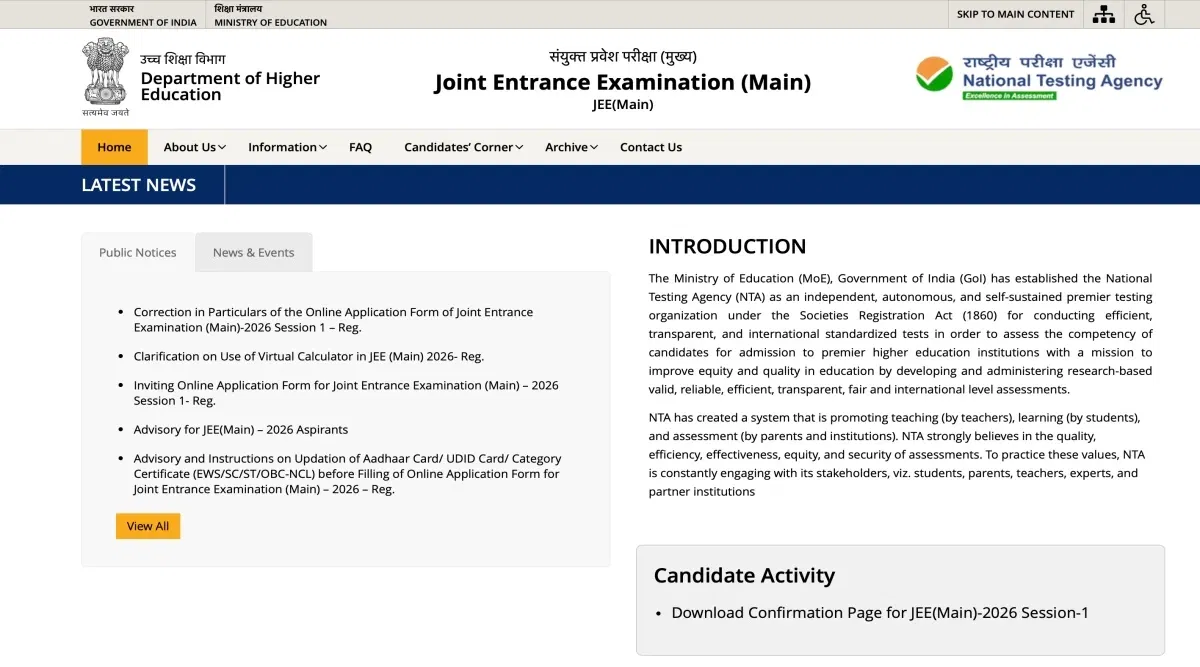JEE Main 2026 Normalisation is a process to ensure equity and impartiality in assessing your performance over many exam shifts or sessions. In this procedure, several variables are considered, such as the candidate's performance in each session and the difficulty of the question papers.
Table of Contents
JEE Main 2026 Normalization: The JEE Main 2026 normalised percentile is calculated by dividing the total number of candidates who appeared in that session by (100 times the number of candidates who appeared in the session with a raw score equal to or less than the candidate).
JEE Main 2026 normalization is a technique of normalizing the relative performance of all applicants who took the JEE Main exam as the basis for percentile scores. It is done by converting the scores for each session into a scale from 100 to 0.
The percentile score displays the percentage of applicants who received a JEE Main Result. Instead of the raw score, it is the adjusted score.
Following normalisation, the desired percentile of 100 will be assigned to each Session's top performer. The marks corresponding to the greatest and lowest JEE Main scores are also converted to percentiles.
What is JEE Main 2026 Normalisation?
In JEE Main 2026, normalisation is a process to ensure equity and impartiality in assessing a candidate's performance over many exam shifts or sessions. The JEE Main question papers vary slightly in complexity across shifts because the exam is administered over multiple shifts to accommodate many applicants.
- The JEE Main normalisation technique helps to consider these variations in difficulty level. It guarantees that no candidate is unduly benefited or harmed because of the degree of difficulty of their shift.
- The idea that a candidate's general competence doesn't change based on the difficulty of the shift is taken into account in the JEE Main normalisation technique. Regardless of the particular questions each applicant must answer, the goal is to provide a level playing field to all the candidates.
Also Read: Which JEE Main 2026 Score will NTA use for the Common Rank List?
How Does NTA do the JEE Main 2026 Normalisation?
The NTR considers the normalisation process as a standard approach and procedure to assess the degree of difficulty of the question paper and students' performance in each Session.
- During this procedure, several variables are considered, such as the candidate's performance in each Session and the difficulty of the question papers.
- The distribution of scores from various sessions is considered in the normalisation formula.
- In this evaluation technique, the candidate's performance indicates that a given session's question paper is more challenging; the normalisation mechanism makes up for it by giving candidates who participated in that Session more excellent normalised scores.
The process of JEE Main 2026 normalization is described below:
- Raw Score Calculation of each Section: Raw scores obtained by students in each section are converted into percentile scores, and then these scores are evaluated to understand the percentage of candidates who have scored equal or below marks in each section separately.
- Calculation of percentile using normalisation formula: Calculation of percentile using normalisation formula is done for each section to ensure the scores are comparable across all the sessions.
- Overall Percentile Calculation: After calculating each section's normalised score, the overall percentile score is normalised, which decides the ranking of the candidates.
Relevant articles related to JEE Main
Essential Terms of JEE Main 2026 Normalisation Process
It's critical to comprehend the essential terms used in the JEE Main 2026 normalization process before diving into the normalization procedure. Candidates are ranked about one another by NTA using percentile ratings. The percentile score shows the percentage of candidates who scored at or below a specific score.
- Percentile Scores: Understanding the significance of percentile scores before understanding the normalisation process is essential. NTA ranks applicants about one another using percentile scores.
The percentile score shows the proportion of candidates who received the same or lower score as a given contender because they consider the distribution of scores within a particular session; percentiles offer a more reliable assessment than raw scores alone.
- Normalisation Formula: Candidate's Percentile Score − Mean Percentile Score of the Session/ Standard Deviation of Percentile Scores in the Session × 100 + 50
- Candidate's Raw Score: The actual score obtained by the candidate in the JEE Main exam.
- Mean Raw Score of the Session: The average raw score of all candidates in the same Session of the JEE Main exam.
- Standard Deviation of Raw Scores in the Session: A measurement of the spread of scores around the mean score.
Adding 50 ensures that the normalised scores fall within a specific range, usually between 0 and 100.
Why is Normalisation Needed in JEE Main?
The needs and requirements of JEE Main 2026 normalization are to maintain the fairness of the examination and to maintain equity and consistency in the evaluation process; all these needs are explained below:
- Fairness of Examination: Normalisation guarantees that all candidates, irrespective of the Session or shift they appear for, have an equal opportunity to compete. It removes the bias caused by differences in the question paper difficulty levels.
- Equity of Evaluation: NTA wants to provide every applicant the same chance, regardless of the specifics of their exam session, by normalising scores.
- Consistency of Evaluation: Normalisation standardised scores to account for variations in question paper difficulty, encouraging uniformity in assessing applicants.







![Indian Institute of Technology, [IIT] Kanpur](https://media.getmyuni.com/azure/college-image/small/indian-institute-of-technology-iit-kanpur.jpg)
![Indian Institute of Technology, [IIT] Roorkee](https://media.getmyuni.com/azure/college-image/small/indian-institute-of-technology-iit-roorkee.jpg)
![Jawaharlal Nehru University, [JNU] New Delhi](https://media.getmyuni.com/azure/college-image/small/jawaharlal-nehru-university-jnu-new-delhi.jpg)
![University of Calcutta, [UC] Kolkata](https://media.getmyuni.com/azure/college-image/small/university-of-calcutta-uc-kolkata.jpg)





























POST YOUR COMMENT